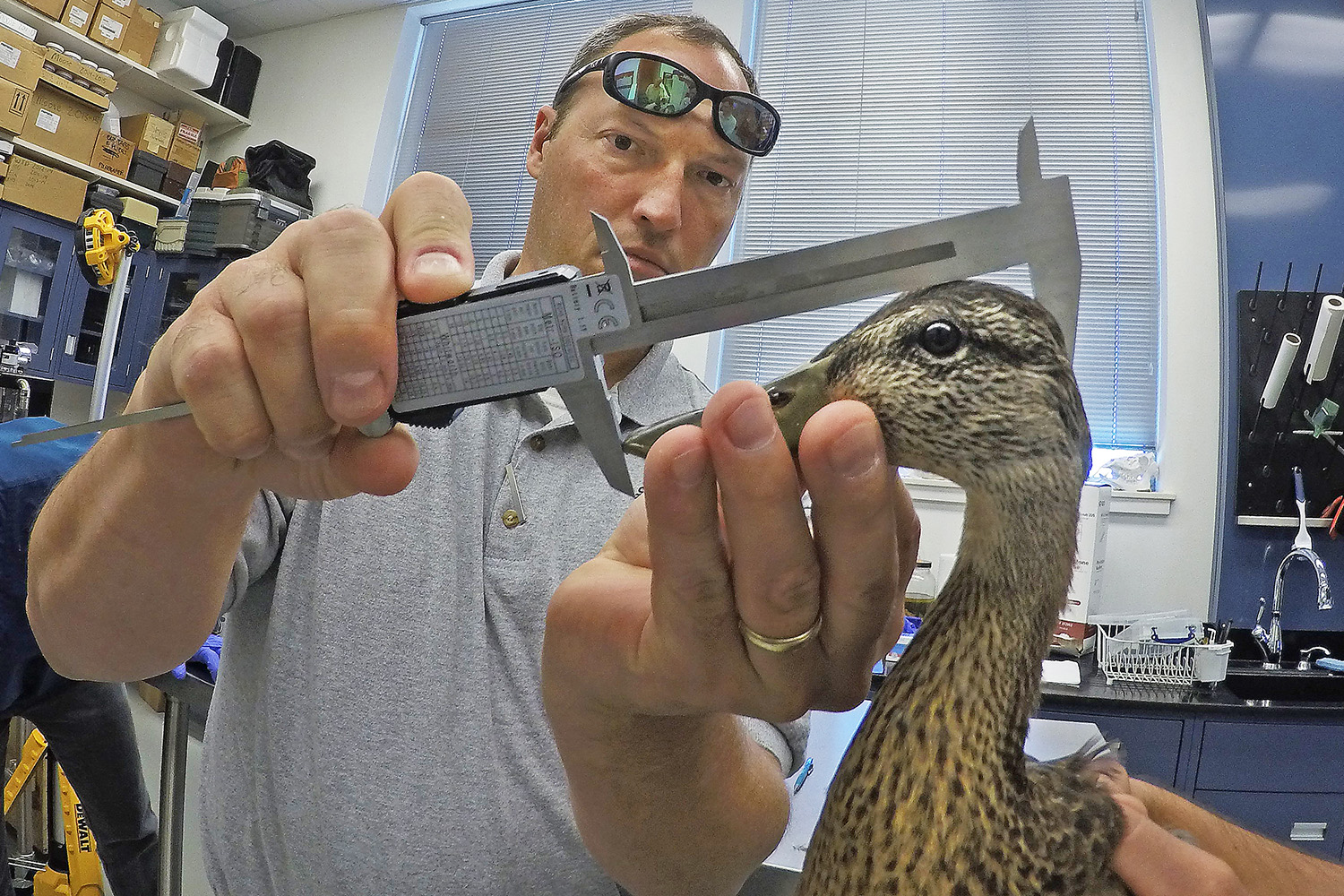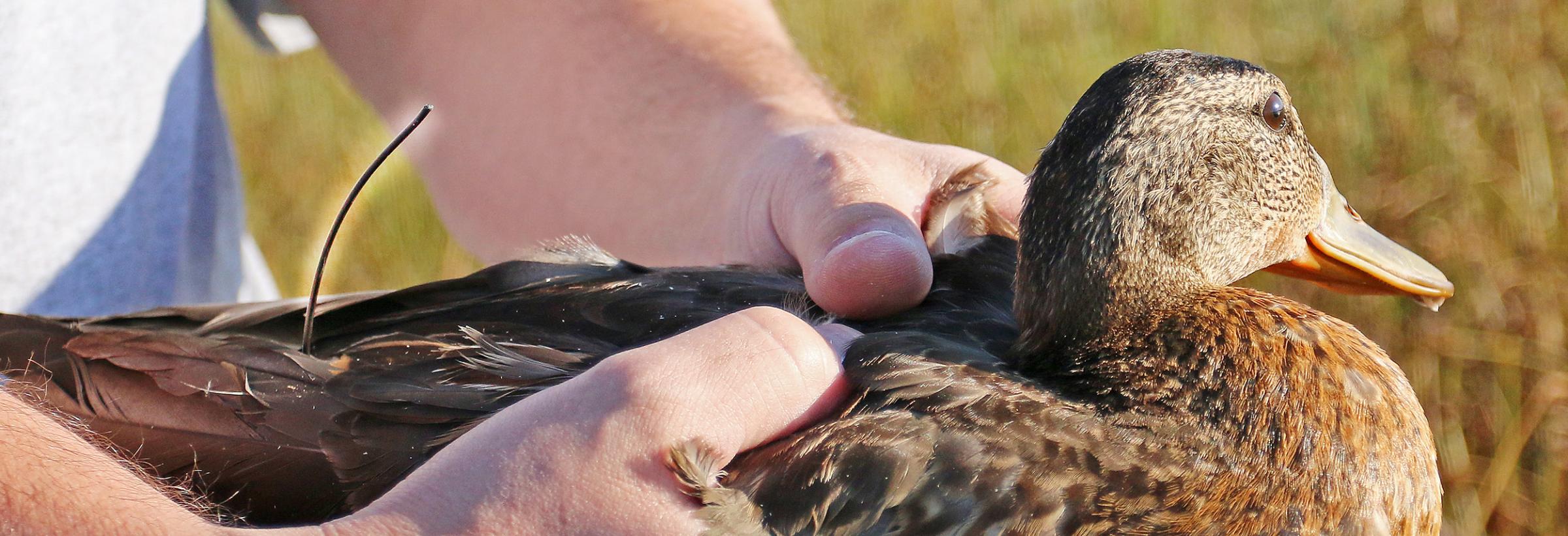
Cynthia Anchor with a hen mallard she trapped for the study.
Advancements in technology are providing biologists the opportunity to reveal late summer movements of ducks in the Dakotas that were once not fully understood.
“Several years back, we started seeing clearer late summer movements of birds out of breeding areas,” said Mike Szymanski, North Dakota Game and Fish Department migratory game bird management supervisor. “We were also getting similar indications from hunters driving through areas of the state who were seeing a lot of duck production, but then come hunting season the birds just weren’t there.”
From a waterfowl ecology perspective, it’s difficult to study ducks in late summer because birds are moving and shuffling around a lot. With previous technology, Szymanski said, biologists would have been driving around in vehicles or flying in airplanes with VHF transmitter receivers trying to find marked birds that could have moved hundreds of miles.
“With the advancements in technology, specifically batteries getting smaller, we had the ability to pursue a GPS transmitter study to look at some of the aspects of post-breeding mallards after they start to fledge or attain flight in late summer,” Szymanski said. “The study design also lends itself to many other uses. With the data, we’ll be able to work the project from many angles and figure out a lot of movement and migration dynamics of mallards in fall.”
The two-year study is a cooperative effort between the Game and Fish Department, South Dakota Game, Fish and Parks and South Dakota State University.
Cynthia Anchor, an SDSU master’s student who spent considerable time in the field capturing ducks, is responsible for managing the GPS data and eventually analyzing and writing up the results of the two-year study in North Dakota and South Dakota.
Szymanski said that while some different techniques were employed in South Dakota to capture the targeted flightless young mallards, swim-in traps baited with corn or barley under water were used in North Dakota.
“We were careful about not capturing and marking too many birds from the same places,” Anchor said. “We wanted our samples spread out across the landscape.”
Both drake and hen mallards were used in the study.
“Mallards worked really well because of their broad distribution across the landscape and because they are of key importance to our hunters,” Szymanski said. “They also are the type of bird that’s going to make these north-northwest post-breeding movements. They’re also a bigger bird and have more room for the transmitter inside the body cavity.”
Because of the availability of new technology, Szymanski said it was decided to not use, for example, the more common external backpack attachments, but instead surgically implant GPS transmitters into birds captured for the study.

Dr. Charlie Bahnson, Game and Fish Department wildlife veterinarian, was one of two veterinarians who surgically implanted GPS units in more than 130 mallards over two years.
“Backpack attachments are very common, but with those a bird has straps running through their armpits or across their chests, plus something on their backs,” Szymanski said. “The birds are very aware of the attached unit and there seems to be some behavioral interactions with the backpacks that we were hoping to avoid.”
The mallards selected for the study were anesthetized very much like humans would be for a surgical procedure, and all precautions were taken to make sure the ducks survived the surgeries in good shape.
Dr. Charlie Bahnson, Game and Fish Department wildlife veterinarian, and Dr. Scott Ford, a contract wildlife veterinarian from Milwaukee, Wisconsin, performed the surgeries and implanted the GPS units in more than 130 mallards over two years.
Bahnson said each surgery took about 20 minutes, but when you factored in recovery time, the entire process took about one hour. The GPS units were implanted in the body cavities of ducks selected for the study, with the antennae extending out the back of the birds.
“The surgery is done in short order … they really don’t know what happened,” Szymanski said. “A lot of times, you’d take the surgical equipment off of them and within minutes they’d be up and looking around … they were as right as rain.”
The first year of the study, Anchor not only captured ducks, but acted as Ford’s surgical assistant.
“We would capture ducks and then I would help him through the surgeries,” she said. “The second year, Scott brought an assistant with him and it freed me up to do so much more fieldwork and continue to capture ducks.”

Mike Szymanski releases a study duck near a North Dakota wetland.
After surgery, marked mallards were transported to the capture sites and released. The transition from the surgical site to the release site also gave the birds additional time to recover.
Because the transmitters are implanted, their batteries cannot be recharged by solar panels like many commonly used external units. So, the researchers needed to be careful about how much data to try to collect and transmit, or risk running the units down too quickly. Anchor said the first year during the premigration period, data was collected every 5 hours. The second year, data was collected every 2.5 hours.
“What happens is the units store data internally and then at whatever interval we set, they’ll kick on and transmit the data,” Anchor said. “The first year we had that set to intervals of about three days and it was really draining the batteries. In the second year, we actually increased the intervals to once every eight days and I think that really conserved the lives of the batteries.”
While there is a ton of data to further analyze, Anchor said she was surprised by some of the movements the marked mallards had made.
“We had one bird, for example, that was marked south of Bismarck that moved up to Canada and spent most of the premigration period in Canada,” she said. “We had another bird that left North Dakota, went to Arkansas and then moved to eastern Ohio. So, we’re seeing some movements that are going to be really tricky to explain.”
Even though the marked birds were captured and released in different areas across the landscape, the data has shown them using the same general areas days and miles down the road.
“We have seen birds that were marked from all over, kind of converge into the same general areas, especially in northeastern South Dakota,” Anchor said. “I think the first year we had two or three birds from North Dakota and two birds from South Dakota all using the same random wetland in South Dakota at the same time. And none of those birds were related, none were marked together. They just happened to end up in the same place.”
While it’s easy to understand ducks pointing their bills south and migrating to warmer climates during the leaner months, Szymanski said people don’t immediately think birds move north, east or west prior to their actual migration.
“Having the ability to collect data in between harvest and marking is very beneficial to painting the picture of their movements,” Szymanski said. “We’re still looking at the movements, trying to figure out if there is a connection to the directions that they go, the distances they go, and how it possibly relates to habitat, weather and other factors.”
Szymanski said another key aspect biologists want to unearth from the study is to make sure they have a handle on whether they’re focusing conservation efforts toward habitat correctly.
“While we focus on pair abundance, brood habitat, where broods are, and things like that, another part of the puzzle that really hasn’t been studied much is habitat use of birds born in an area, attain flight and then start moving around the landscape,” he said. “Are they using those same habitats or are they using habitats that we’re maybe overlooking or not prioritizing as highly in our conservation strategies?”

Mike Szymanski, Game and Fish Department migratory game bird management supervisor, measures the head length of a young drake mallard prior to surgery. This is one of several measurements biologists took to evaluate the body condition of ducks in the study.
Szymanski said that while the study will be used to make sure biologists aren’t missing out on somewhat unknown areas used by ducks, it will also be used to exemplify the importance of intact wetland communities as the data suggests birds utilize a lot of places.
“You just can’t say, well, we’re going to keep that spot over there for ducks and take all of this off the map and everything is going to be fine,” he said. “That’s just really not how it works. We’ve known that for a long time and we’ve got some very good illustrations of that through the study.”
Knowing that the some of the GPS marked mallards could be harvested during hunting seasons along the course of the flyway, Anchor is also looking at survival and harvest of these birds compared to normal preseason banded mallards.
“I’m a waterfowl hunter and I knew coming in this was going to be part of the project, and it’s been kind of interesting to hear some of the stories from hunters,” she said. “In North Dakota, our very first bird was harvested by a 10-year-old, a new hunter who had never shot a mallard before.”
The transmitter birds form the Dakotas are fitted with leg bands. “Transmitter Inside Bird” is stamped on the leg bands of those birds captured and released in North Dakota.
“In addition to the standard USGS band we put on all waterfowl that we mark, the band that says ‘Transmitter Inside Bird’ also has my work phone number so that people can call me,’ Szymanski said. “We try to get the transmitters back in case there’s data that we feel like we might be able to retrieve if we send it back to the manufacturer.”
The South Dakota study birds have the South Dakota waterfowl biologist’s phone number on the band.
“Anybody who harvests a bird that has a band on it, whether it’s one of our transmitter birds or a regular banded duck, goose, mourning dove or any other species should go to the bird banding lab website and report the band,” Szymanski said. “It takes just a couple minutes, is easy to do, it plays a big part in population management, and you get to keep the band.”

